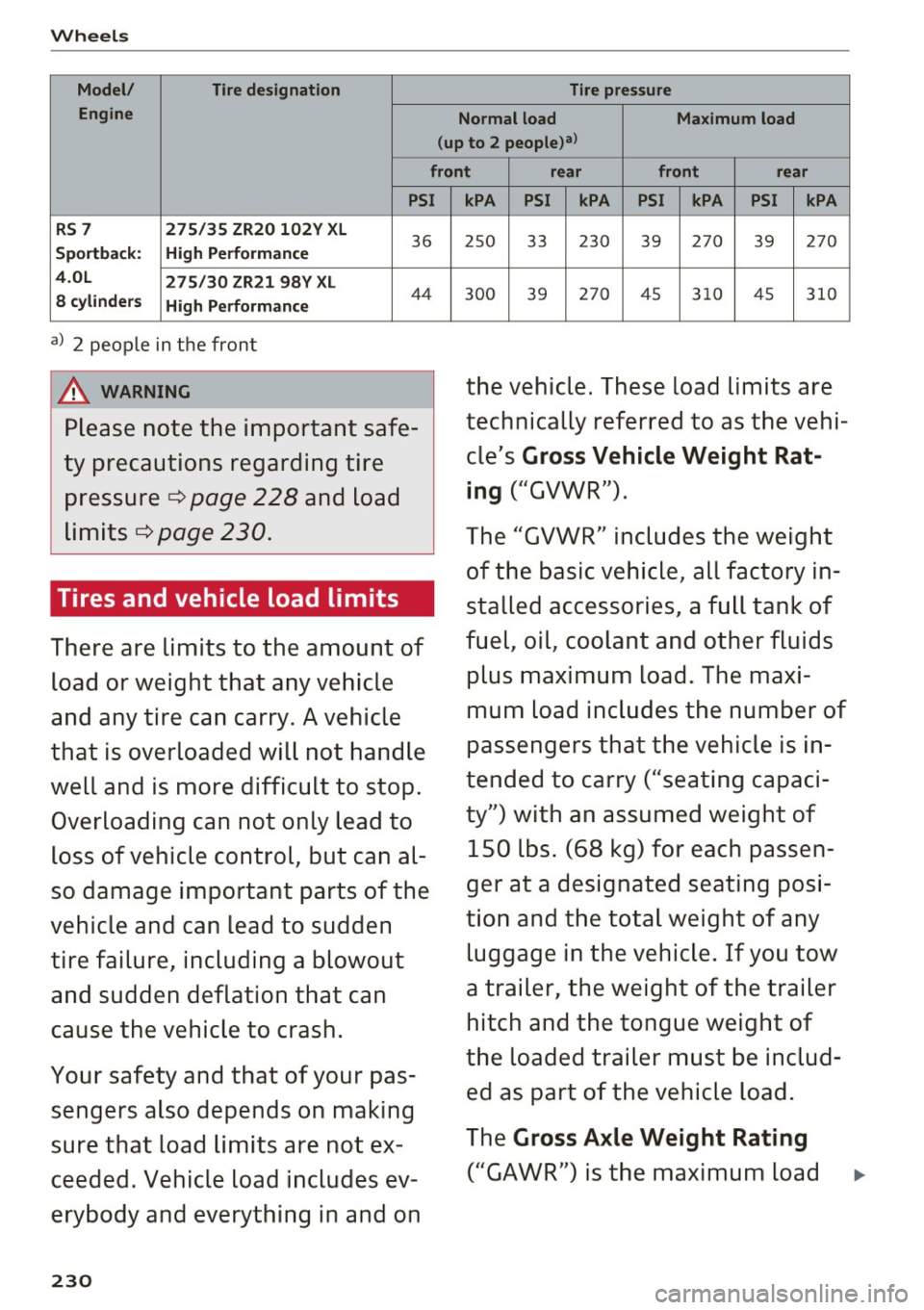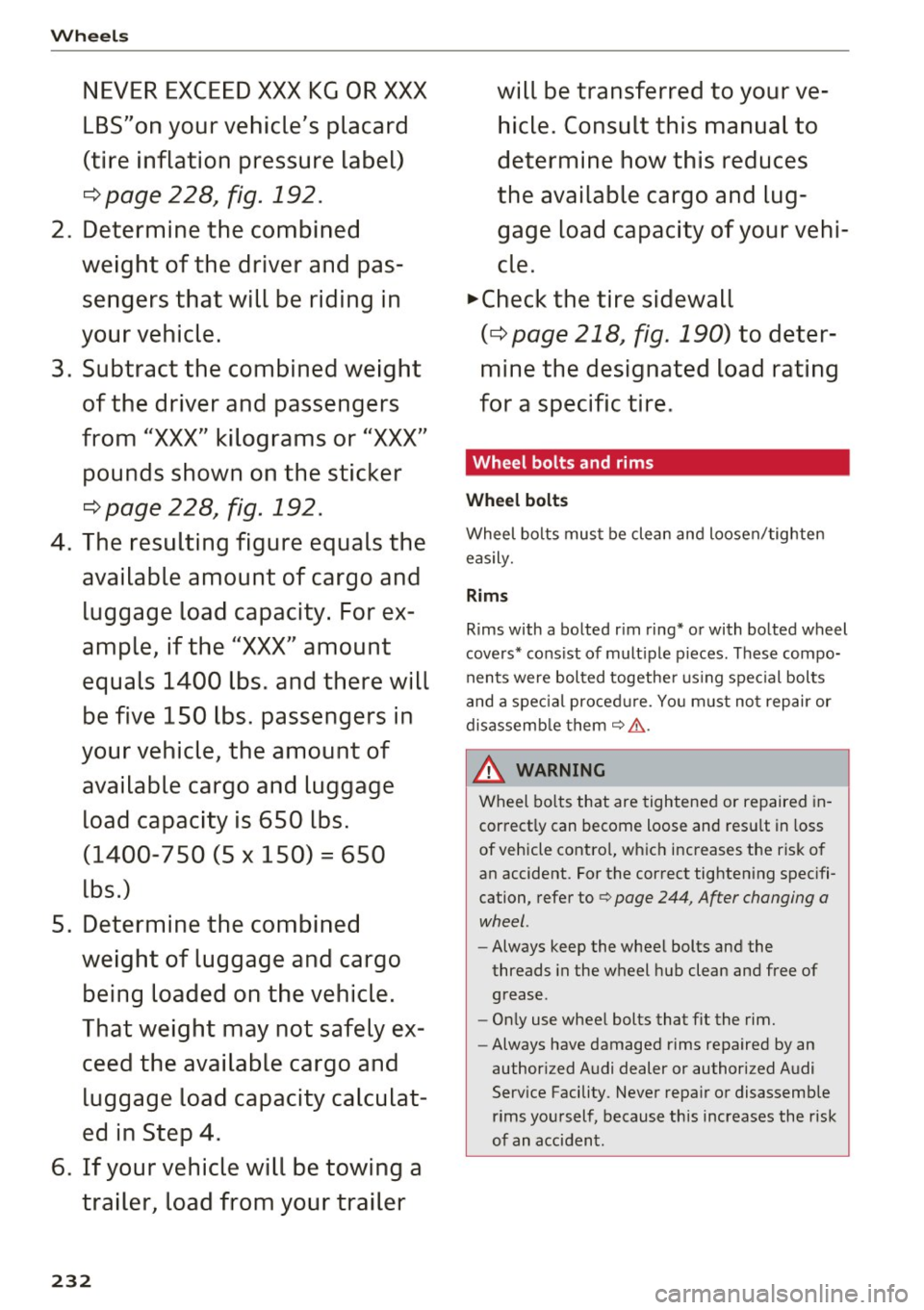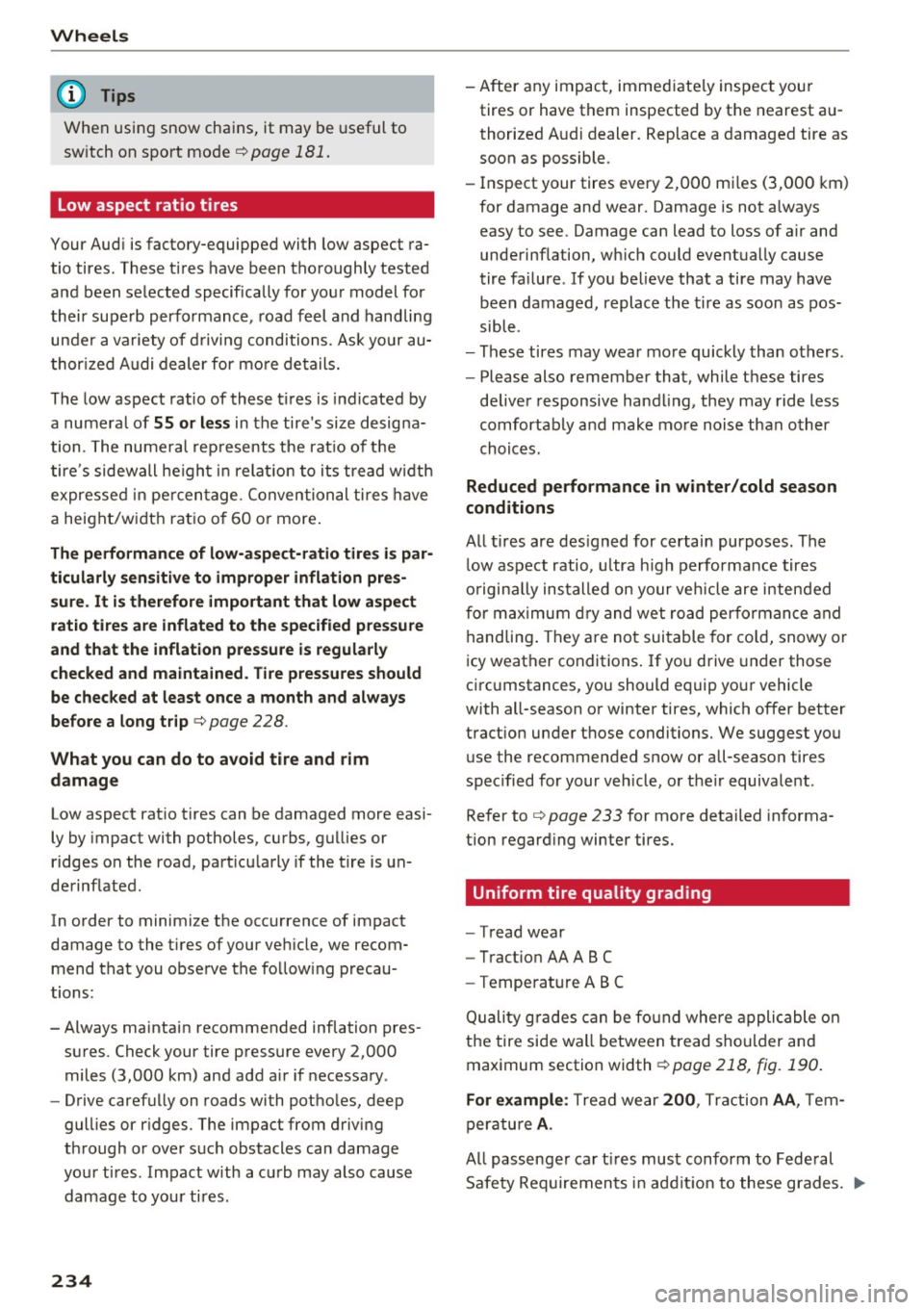2016 AUDI RS7 SPORTBACK tire pressure
[x] Cancel search: tire pressurePage 224 of 282

Wheels
(a) Curb weight
(b) Accessory weight
(c) Vehicle capacity weight, and
(d) Production options weight
Maximum (permissible )
inflation pressure
means the maximum cold infla
tion pressure to which a tire may be inflated. Also called "maxi
mum inflation pressure ."
Normal occupant weight
means 150 lbs . (68 kilograms)
times the number of occupants
seated in the vehicle up to the to
ta l seating capacity of your vehi
c le .
Occupant distribution
means distribut ion of occupan ts
in a vehic le .
Outer diameter
means the overall diamete r of an
inflated new tire.
Overall width
means the l inear distance be
tween the exter iors of the side
walls of an infla ted tire , including
elevations due to labeling , deco
rations, or protective bands or
r ibs.
222
Ply
means a layer of rubber -coated
pa rallel cords.
Production options weight
means t he comb ined we ight of
those insta lled regular production
options weighing over 5 lbs . (2 .3
kg) in excess of those standard
items which they replace , not pre
viously considered in curb weight or accessory weight, inc luding
heavy duty brakes, ride levelers,
roof rack, heavy duty battery, and
special trim.
Radial ply tire
means a pneumatic tire in which
the ply co rds that extend to the
beads are laid at subs tantially 90
deg rees to the centerline o f the
tread .
Recommended inflation
pressure
see~ page 221, Cold tire infla
tion pressure.
Reinforced tire
means a tire designed to operate
at highe r loads and at h igher in
flat ion pressures than t he corre
spond ing standa rd tire . R ein
forced tires may be identified as .,.
Page 225 of 282

...
"XL" "xl" "EXTRA LOAD" or "RF" ' ' '
on the sidewall.
Rim
means a metal support for a tire
or a tire and tube assembly upon
which the tire beads are seated .
Rim diameter
means nominal diameter of the
bead seat. If you change your
wheel size, you will have to pur
chase new tires to match the new
rim d iameter.
Rim size designation
means rim diameter and width.
Rim width
means nominal distance between
r im flanges.
Sidewall
means that portion of a tire be
tween the tread and bead .
Speed rating (letter code )
means the speed at wh ich a tire is
designed to be driven for exten d
ed periods of t ime . The ratings
range from 93 mph (150 km/h)
to 186 mph (298 km/h)
¢ table
on page 219.
Yo u may not find
;;/ this information on all tires be-
,.,
; cause it is not required by law. V, N
"' ...
Wheels
T he speed rating letter code,
where applicable, is molded on
the tire sidewall and indicates the
maximum pe rmissible road
speeds
¢ & in Winter tires on
page 233 .
Tire pressure monitoring
system*
means a system that detects
when one or more of a vehicle's
tires are underin flated and illum i
na tes a low tire pressure wa rning
telltale.
Tread
means that port ion of a tire that
comes into contact with the road.
Tread separation
means pulling away of the tread
from the tire carcass .
Treadwear indicators (TWI)
means the projections within the
principal grooves designed to give
a visua l indication of t he degrees
of wear of the tread . See
¢ page 226, Treadwear indicator
for mo re info rma tion on measu r-
ing tire wear. .,.
223
Page 228 of 282

Wheels
-For technical reasons, it is not possible to use tires from oth
er vehicles - in some cases,
you cannot even use tires from
the same vehicle model.
-Make sure that the tires you select have enough clearance
to the vehicle. Replacement
tires should not be chosen
simply based on the nominal size, because tires with a dif
ferent construction can differ greatly even if they are the
same size. If there is not enough clearance, the tires or
the vehicle can be damaged and this can reduce driving
safety and increase the risk of
an accident.
-Only use tires that are more than 6 years old when abso
lutely necessary and drive
carefully when doing so.
-Do not use run-flat tires on your vehicle. Using them when
not permitted can lead to ve
hicle damage or accidents.
-If you install wheel covers on the vehicle, make sure they al
low enough air circulation to
cool the brake system. If they
do not, this could increase the
risk of an accident.
226
Tire wear/damage
Fig. 191 Tire profile : treadwear indica
tor
Tire wear
Check the tires regularly for wear.
-Inflation pressure that is too low or high can increase tire wear
considerably.
-Driving quickly through curves, rapid acceleration and heavy
braking increase tire wear.
-Have an authorized Audi dealer
or authorized Audi Service Facili
ty check the wheel alignment if
there is unusual wear.
-Have the wheels rebalanced if an imbalance is causing noticeable
vibration in the steering wheel. If you do not, the tires and other
vehicle components could wear
more quickly.
Treadwear indicator
The original tires on your vehicle have 1/16 inch (1.6 mm) high
"wear indicators" ¢fig.
191 ...
Page 230 of 282

Wheels
Tire pressure
Fig. 192 Driver's side 8-pillar: tire pres
sure label
io
-
r~ . --c =-- -- ~-,ucu -~- ::- .- :""'- -- .- =...-- .)-@-:- -. l i
n,.....,...__ ........ .,._... ..... ._....,. .... _ ... l ..................... ......,....,..,.......,.... ... ..
1W IIZE COlD tW. l"flCSIUIIE.
PNE U ~ """'°"' OU "CU$ A ffllOII>
- KP a PSI
- KPA.
a PSI
- KPA. -PSl
Fig. 193 Tire pr essur e lab el
SEf.OWNU "S MANUAL FOR ADDmONAl IHJOAMATlON V091JU:MAHUC1. 0U"'Ol"IIETA.Qlll POUJIIPlUSDf
,U:NSEIGrEME"ITS
J
The correct tire pressure for tires
installed at the factory is listed on
a label. The label is located on the B-pillar
¢fig. 192, ¢fig. 193.
Use the tire pressure specified for
a normal vehicle load when the
vehicle is partially loaded¢
table
on page 230 .
If driving the vehi
cle when fully loaded, you must increase the tire pressure to the
maximum specified pressure¢.&-
228
Checking/correcting tire
pressure
,..Check the tire pressure at least
once per month and also check it before every long drive .
.,..Always check the tire pressure
when the tires are
cold. Do not
reduce the pressure if it increas
es when the tires are warm.
.,.Check the labe l¢
fig. 193 for
the correct tire pressure based
on vehicle load .
.,..Correct the tire pressure if nec
essary .
.,..Vehicles with Tire Pressure Mon
itoring System*: store the modi
fied tire pressure in the Infotain ment system ¢
page 23 7.
A WARNING
Always adapt the tire pressure
to your driving style and vehicle
load.
-Overloading can lead to loss of vehicle control and increase
the risk of an accident. Read
and follow the important safe
ty precautions in ¢
page 230,
Tires and vehicle load limits.
-The tire must flex more if the tire pressure is too low or if
the vehicle speed or load are too high. This heats the tire up .,.
Page 231 of 282

too much. This increases the risk of an accident because it
can cause the tire to burst and result in loss of vehicle con
trol.
-Incorrect tire pressure in
creases tire wear and has a
negative effect on driving and
braking behavior, which in
creases the risk of an accident .
(D Note
Replace lost valve caps to re
duce the risk of damage to the
tire valves.
Tire pressure table
Please note that the information
contained in the following table
was correct at the time of print ing, and the information is sub
ject to change. If there are differ
ences between this information
and the tire pressures specified
on the label on the driver's side B pillar, always follow the specifica
tion on the B-pillar label
¢ page 228, fig. 192.
Wheels
'® For the sake of the environment
Tire pressure that is too low in
creases fuel consumption .
Audi recommends using the
tire pressure specified for a normal load
¢ table on
page 230
or for a full load
when the vehicle is partially
loaded.
Make sure that the tire designa
tion on your tire matches the des ignation on the tire pressure label
and the tire pressure table.
The following table lists recom
mended tire pressures in cold
tires according to the load and
the size of the tires installed . .,.
229
Page 232 of 282

Wheels
Model/ Tire designation Tire pressure
Engine Normal load Maximum load
(up to 2 people)a>
front rear front rear
PSI
RS 7 275/35 ZR20 102Y XL
Sportback: High Performance
36
4.0L 275/30 ZR21 98Y XL
8 cylinders High Performance
44
a) 2 people in the front
A WARNING
Please note the important safe
ty precautions regarding tire
pressure ¢
page 228 and load
limits ¢
page 230.
Tires and vehicle load limits
There are limits to the amount of
load or weight that any vehicle
and any tire can carry. A vehicle
that is overloaded will not handle
well and is more difficult to stop. Overloading can not only lead to
loss of vehicle control, but can al
so damage important parts of the
vehicle and can lead to sudden
tire failure, including a blowout and sudden deflation that can
cause the vehicle to crash.
Your safety and that of your pas sengers also depends on making
sure that load limits are not ex
ceeded . Vehicle load includes ev
erybody and everything in and on
230
kPA PSI kPA PSI kPA PSI kPA
25 0 33 230 39 270
39 270
30 0 39 270 45 310 45
310
the vehicle. These load limits are
technically referred to as the vehi
cle's
Gross Vehicle Weight Rat
ing
("GVWR").
The "GVWR" includes the weight of the basic vehicle, all factory in
stalled accessories , a full tank of
fuel, oil, coolant and other fluids
plus maximum load. The maxi
mum load includes the number of
passengers that the vehicle is in
tended to carry ("seating capaci
ty") with an assumed weight of 150 lbs. (68 kg) for each passen
ger at a designated seating posi
tion and the total weight of any luggage in the vehicle. If you tow
a trailer, the weight of the trailer hitch and the tongue weight of
the loaded trailer must be includ ed as part of the vehicle load.
The
Gross Axle Weight Rating
("GAWR") is the maximum load
Page 234 of 282

Wheels
NEVER EXCEED XXX KG OR XXX
LBS"on your vehicle's placard
(tire inflation pressure label)
¢page 228, fig. 192.
2. Determine the combined
weight of the driver and pas
sengers that will be riding in
your vehicle.
3. Subtract the combined weight
of the driver and passengers
from
"XXX" kilograms or "XXX"
pounds shown on the sticker
¢ page 228, fig. 192.
4. The resulting figure equals the
available amount of cargo and
luggage load capacity. For ex
ample, if the "XXX" amount
equals 1400 lbs. and there will
be five 150 lbs. passengers in
your vehicle, the amount of available cargo and luggage
load capacity is 650 lbs.
(1400-750 (5 X 150) = 650
lbs.)
5. Determine the combined
weight of luggage and cargo being loaded on the vehicle.
That weight may not safely ex ceed the available cargo and
luggage load capacity calculat
ed in Step 4.
6. If your vehicle will be towing a trailer, load from your trailer
232
will be transferred to your ve
hicle. Consult this manual to
determine how this reduces
the available cargo and lug
gage load capacity of your vehi
cle.
~check the tire sidewall
(¢page 218, fig. 190) to deter
mine the designated load rating
for a specific tire.
Wheel bolts and rims '
Wheel bolts
Wheel bolts must be clean and loosen/tighten
easily.
Rims
Rims with a bolted rim ring* or with bolted wheel
covers* consist of multiple pieces. These compo
nents were bolted together using special bolts
and a special procedure . You must not repair or
disassemble them
9 &. .
_&. WARNING
Wheel bolts that are tightened or repaired in
correctly can become loose and result in loss
of vehicle control, which increases the risk of
an accident. For the correct tightening specifi
cation, refer to
9 page 244, After changing a
wheel .
-Always keep the wheel bolts and the
threads in the wheel hub clean and free of
grease .
- Only use wheel bolts that fit the rim.
- Always have damaged rims repaired by an
authorized Audi dealer or authorized Audi
Service Facility. Never repair or disassemble
rims yourself, because this increases the risk
of an accident.
Page 236 of 282

Wheels
(D Tips
When using snow chains, it may be useful to
sw itch on sport mode
¢ page 181.
Low aspect ratio tires
Your Aud i is factory-equipped with low aspect ra
tio tires. These tires have been thoroughly tested
and been selected specifically for your model fo r
thei r supe rb perfo rmance, road feel and handling
unde r a va riety of d riving conditions . As k yo ur au
thor ized Audi dealer for mo re de tails.
The low aspect ratio of these t ires is indicated by
a nume ra l of
55 or less in the tire's size desig na
tion . The nume ra l rep resents the rat io of t he
tire 's sidewall he igh t in relat io n t o it s tread w idth
e xpresse d in percen tage. Convention al ti res have
a height/w idth ratio o f 60 o r more .
The performance of low -aspect-ratio tires is par
ticularly sensitive to improper inflation pres
sure. It is therefore important that low a spect
ratio tires are inflated to the specified pre ssure
and that the inflation pressure is regularly
checked and maintained. Tire pressures should
be checked at le ast once a month and alwa ys
before a long trip¢
page 228.
What you can do to avoid tire and rim
damage
Low aspect rat io tires can be damaged more easi
ly by impact with potholes, curbs, gullies or
ridges on the road, pa rt icu la rly if the t ire is un
de rinflated.
In order to minimize the occurrence of impact
damage to the t ires of your ve hicle, we recom
mend that you observe the fo llow ing precau
tions:
- Always maintain recommended inflation pres
su res . Check your tire pressure every 2,000
miles (3,000 km) and add air if necessary .
- Drive caref ully on roads with potho les, deep
gul lies or r idges . The impact from drivi ng
through or over s uch obstacles can damage
you r tires. Im pact with a cu rb may also cause
damage to you r tires .
234
-After any impact, immed iate ly inspect you r
tires or have them inspected by the nearest au
thorized Aud i dealer. Replace a damaged tire as
soon as possible.
- Ins pect your tires every 2,000 mi les (3,000 km)
for damage and wear . Damage is not always
easy to see . Damage can lead to loss of a ir and
underinfla tion, w hich could even tua lly cause
tire fa ilure . If yo u be lieve that a tire may have
been damaged, replace the tire as soon as pos
sible.
- These tires may wear mo re quickly than others .
- Please also remember that, while t hese tires
delive r responsive hand ling, they may ride less
comforta bly and make mo re noise than o ther
choi ces.
Reduced performance in winter/cold season
conditions
A ll ti res are des igned for certain purposes. The
l ow aspect ratio, ultra h igh performance tires
o rigina lly ins talled on your veh icle are inten ded
f o r m ax imu m dr y and wet ro ad perfo rma nce and
handling . They a re not sui table for co ld, snowy or
i cy weather conditions . If yo u drive under those
c ir cu mstances, you should equip yo ur vehicle
with all-season o r winter tires, which offer better
tract ion under t hose conditions. We suggest you
use the recommended snow or a ll-season tires
spec ified for your vehicle, o r th e ir equiva le nt.
Re fer to
c:> page 233 for more detailed in forma
tion regard ing winter tires.
Uniform tire quality grading
- Tread wea r
- Tract io n AA AB C
- Tempe rature ABC
Quali ty g rades can be fo und whe re appli cab le on
t h e tire side wall between tread shou lder and
max imum section width
¢ page 218, fig. 190 .
For example : Tread wear 200 , Traction AA , Tem
per atu re
A .
All passenge r ca r tir es mus t conform to Fede ral
Safety Req uiremen ts in add it io n to these grades . ..,.